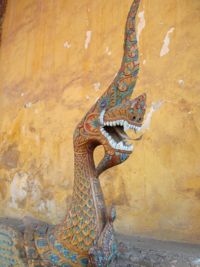The Phaya Naga are serpent-like creatures believed by locals to live in the Laotian stretch of the Mekong river.
Appearance
Stories say that on certain stretches of the Mekong River, an evening walker can behold a magical sight. At around 8 pm during the full moon of October, hundreds of egg-sized balls of red flame rise from the water like a myriad misdirected Hadoukens, floating up towards the stars, where they quietly disappear.
History
Lao myth maintains that the Naga are the protectors of Vientiane, and by extension, the Lao state. The Naga association was most clearly articulated during and immediately after the reign of Anouvong. Leup Phasun, an important poem from this period discusses relations between Laos and Siam in a veiled manner, using the Naga and the Garuda, to represent Laos and Siam, respectively. The Naga is incorporated extensively into Lao iconography, and features prominently in Lao culture throughout the length of the country, not only in Vientiane.
Theories
People in both Laos and Thailand attribute the Naga fireballs to these creatures, which are likely to be extremely overgrown giant mottled eels (Anguilla marmorata), an undiscovered species of eel or just methane. In 2003, reporters from a Thai television station claimed that the fireballs were simply tracer bullets, fired as part of the Buddhist celebrations. The Laotian government responded by arresting the reporters.
See also
External links
- Mekong River Commission paper on eels (pdf)
- Dr. Kanoksilpa, a pediatrician at Nong Khai hospital, studied this phenomenon for four years and concludes the most likely explanation to be seasonal accumulations of methane gas. (Panida, 2538 B.E. : 78-79)Thai folk : The knowledge of Thai life-style[1]

